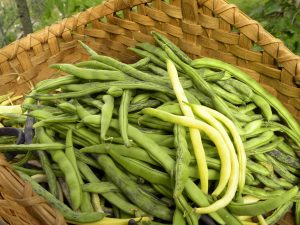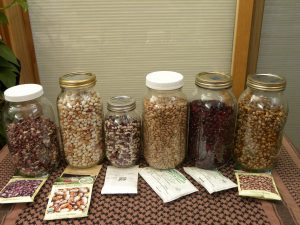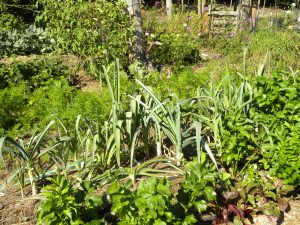
Curing Winter Squash in 2018
Winter squash (Cucurbita spp.) is an amazing food resource – prolific, nutritious and with a long shelf life requiring no electricity. We humans love it as well as our chickens and goats. Over the past few years I have branched (vined?) out to try more varieties, especially heirlooms, to honor and help preserve what the native people of this region cultivated. Those master plant breeders cared so well for this land for thousands of years, including living through climatically challenging times. We immigrants could learn a lot from them.
Here is a review of our trials so far, starting with our latest finds.
Seminole Pumpkin or Chassa Howitska (Cucurbita moschata)
I first heard of this squash in 2018, but it was cultivated by the Seminole people in the Florida Everglades since the 1500s. I came across it in the Fedco catalog’s Indigenous Royalties program. They included a disclaimer that we might be too far north to succeed with this crop, but it’s claimed pest and disease resistance tempted me to risk it.

Seminole Trying to Cross the Road
It was slow to get started in the cool spring we had, but once it got going there was no stopping it. It grew farther and wider than I’d planned for or imagined possible. It snaked out into the road, pulled small trees down in its path and sent down roots everywhere it touched the ground. I had to climb into the patch regularly to free my persimmons, jostaberries and beach plums, not an easy feat. The foliage was huge, dense and deep green all the way to our first frost. I never saw damage from vine borers, squash bugs or powdery mildew.

Seminole Squash Vines (see the blue of my shirt in the jungle?)
I also couldn’t see much fruit through the greenery, leaving me to wonder if we’d actually have a crop from it at all. But after the frost hit, I ventured into the tangle with 5 gallon buckets, trip after surprising trip eventually bringing in 414#, all from an original 6 planting spots with a couple seeds in each.

Seminole Ripening on Vines Just Hit by Frost
None of it was totally vine-ripened. The small green fruits we used like zucchini and shared with the goats. Any that had started to turn orange I brought inside hoping they would ripen. This was in October. Over the next couple of months, any that showed signs of rotting we cleaned up and ate ourselves or fed to the animals. By January a batch of 50# had totally ripened, living in buckets in our dining room. These can supposedly last for years without even being kept cool. I’ll be testing that and can report back!

Cured Seminole Pumpkin
As for taste… the immature ones weren’t sweet, but were more nutty and like summer squash. As they ripen they sweeten up. They have made lovely fluffy pies and are especially great for pumpkin bread. Their size of 3-5# each is handy for using in the home kitchen.
I’ll definitely plant these again this spring, but farther from the street!
Boston Marrow (Cucurbita maxima)
This heirloom seed came to me from The Piscataqua Seed Project in 2018. It can be traced to upstate New York where it may have been gifted from Native Americans to settlers, then documented in Salem, Massachusetts in 1831.

Boston Marrow Squash
I grew one plant in one of our young orchards. It happily climbed up a small nearby oak. As expected, it made one large fruit, an impressive deep orange 20-pounder. We cracked it open in February and it cooked up sweet and moist. I made a few delicious pies and squished squash dishes. My complaint is the size. Chopping it up and having to process it all at once is not convenient at a typical home scale. If you cook for many people at once this is a great one, which I’m sure is why it is becoming popular with chefs at farm to table restaurants.
Long Pie (Cucurbita pepo)

Long Pie Pumpkin, Ripe and Stored through April
I received seeds for Long Pie at a Seacoast Permaculture seed swap in a homemade envelope with no photo. In 2016 I planted a variety of winter squash, including these seeds, in our front garden and orchard. That turned out to be a big vine borer year. Every few years there is a surge in their population and we lose much or most of our crop. Those are the ups and downs, the boom and bust cycles of nature, which I don’t worry too much about. But one vine kept going after all the others succumbed. It formed long dark green fruits looking like a weird cross between a zucchini and maybe a butternut. I didn’t know what to do with them so left them.
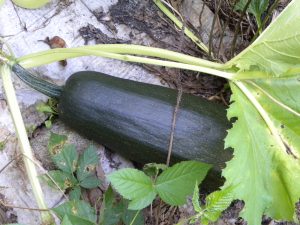
Long Pie Pumpkin, Still Green on the vine
When they started turning orange in the late summer I had enough information to research and realize what they were.
I was already a fan after seeing them shrug off the pest pressure that year. Their long-keeping nature, handy size and shape, and how they sweeten nicely over time keeps them on our must-grow list. Other local growers have noticed it as well.
Delicata (Cucurbita pepo)

Delicatas in Storage in April
It is my personal history with Delicatas that endears them to me. When I was a beginning grower in the early 1990s, farmer David tried these out. Small and sweet with edible skin, they were perfect for me as I was living alone, making meals for one. I love them halved, sprinkled with cinnamon and baked. They are not super pest resistant or prolific, but they keep well for many months.
It is also an heirloom. I buy the Zeppelin variety which can be traced back to 1894, before more recent breeding programs.
Butternut (Cucurbita moschata)

A Baby Butternut
Everyone knows Butternut squashes, right? I thought I did, but only recently learned that they are direct descendants of the Canada Crookneck grown by the Haudenosaunee and likely other New England, New York and Canadian tribes (see “Seven Sisters” by Dr. Fred Wiseman). More recently they have been selected for straight necks, but still maintain resistance to vine borers, a trait common to C. moschata.
I’ve grown these for years, and never intend to give them up. This year I grew both Waltham and Burpee, with the Waltham being the better producer. Butternuts have generally been my best keepers, sometimes all the way until July. This year they haven’t been lasting as well, which I expect is because none of them escaped chew
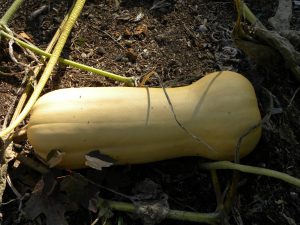
Butternut Squash
marks from rodents in the fall. Maybe the Seminole pumpkins will outdo them on shelf life, we’ll see. They are sweet and delicious and a convenient size.
Looking to the Past, Planning for the Future
I had thought this blog post was going to be a simple one on a simple topic. However, while writing it, I found myself struggling with conflicting feelings and thoughts. I love this food source and I have a lot of gratitude and respect for the people who developed it. But honestly, it has come to me more through theft and appropriation than gifting.
The case could be made that I shouldn’t be on this land – there are others who should be. But here I am anyway, living in the wake of histories and choices that I didn’t have a say in. And – where else could I be? I’m ½ Irish and ½ Italian with no citizenship rights in either country. There isn’t a clear way to go back.
We can learn so much from Indigenous people. In fact, permaculture specifically looks to cultures who live in good relationship to the land. Many Native Americans are urging the rest of us to learn from them before we destroy us all.
I have no answers here, only questions and struggles. But sometimes hard questions are more important than quick answers.
I plan to continue to grow Native American crops – squash, beans, corn, potatoes, tomatoes and more – and try to give credit where it is due. I will also pay attention to current issues in native communities and find ways to give back for all that I receive.
Here are just a few projects and resources to look to for ways to support indigenous peoples rights.
The NH Coalition for Indigenous Peoples’ Day
Cowasuck Band of the Pennacook Abenaki People
Grand Canyon Trust (If you went to SELT‘s 2019 Wild and Scenic Film Fest in Portsmouth NH in April you’ll remember the film on this subject: Too Precious to Mine)






